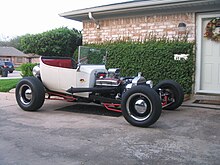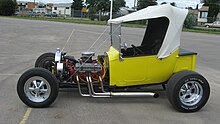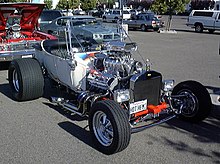T-bucket
This article needs additional citations for verification. (September 2014) |

A T-bucket (or Bucket T) is a hot rod, based on a Ford Model T[1] of the 1915 to 1927 era, but extensively modified. T-buckets were favorites for greasers.[citation needed]
History
Model Ts were hot-rodded and customized from the 1920s on, but the T-bucket was specifically created and named by Norm Grabowski in the 1950s.[citation needed] This car was named Lightning Bug,[citation needed] better known as the Kookie Kar, after being redesigned by Grabowski and appearing in the TV show 77 Sunset Strip, driven by character Gerald "Kookie" Kookson. The exposure it gained led to numerous copies being built.
A genuine T-bucket has the two-seater body of a Model T roadster (with or without the turtle deck or small pickup box), this "bucket"-shaped body shell giving the cars their name. A Model T-style radiator is usually fitted, and even these can sometimes be barely up to the task of cooling the large engines fitted. Windshields, when fitted, are vertical glass like the original Model T.
Today, T-buckets remain common. They generally feature an enormous engine for the size and weight of the car, generally a V8, along with tough drivetrains to handle the power and large rear tires to apply that power to the road. The front wheels are often much narrower than the rear wheels, and are often motorcycle wheels.
Replicas

Since the last Model Ts were built in 1927, most modern T-buckets use replica fiberglass bodies. By the 1950s, original steel Model T bodies that had not been completely worn out were becoming increasingly hard to find and in 1957 the first fiberglass T-Bucket body[2] (based on the 1923 version) was introduced by the short-lived Diablo Speed Shop in Northern California. Of the only two or three bodies built by Diablo, one was purchased by Southern California hot rod builder Buzz Pitzen and became the world's first fiberglass T-bucket.[3]
Show cars

Most are built purely for street or show use, and the big engines are more for show than for need — many are more powerful than the vehicles can actually make use of. Although the body shell is original in appearance, engines of a wide variety of makes are commonly used. The small-block Chevrolet is a common choice, since it is relatively small, light, easy to obtain and to improve, and performs well. Four-cylinder engines are common also, especially if the car is used regularly. Many install blowers (superchargers) on their engines, and people use modern fuel-injected engines.
References
- ^ Jeff Breitenstein. Ultimate Hot Rod Dictionary: A-Bombs to Zoomies. MotorBooks International. pp. 212–. ISBN 978-1-61059-235-2.
- ^ http://www.tbucketplans.com/2010/04/03/the-real-history-of-the-fiberglass-t-bucket-body/ Archived April 15, 2011, at the Wayback Machine
- ^ http://www.tbucketplans.com/2010/05/14/the-worlds-first-fiberglass-t-bucket-hot-rod-buzz-pitzens-glass-image/ Archived February 14, 2011, at the Wayback Machine
